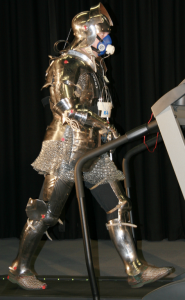Chemical suits often limit activity to perhaps 20 minutes to half an hour. Image what is is like to work in medieval armour? It may have lead to the defeat of the stronger French armour in the Battle of Agincourt.

Dr Graham Askew (biomechanics) at the University of Leeds has tested replica 15th-century armour on a treadmill.
The modern-day knights used 2.1 to 2.3 times more energy walking with their armor on compared with walking without it. Running with armor took 1.9 times the energy as running armor-free.
The result, Askew said, is that men in armor end up moving much more slowly than men without armor. This effect is only exacerbated with age: At his maximum aerobic capacity, an average 38-year-old man could cover about 5.5 feet (1.7 meters) per second, compared with 8.8 feet (2.7 m) per second for an unarmored 38-year-old. With a maximum walking speed of 4.6 feet (1.4 m) per second, an armored 55-year-old would have trouble keeping up.
From the BBC website
In the Battle of Agincourt in 1415, French knights were defeated by their English counterparts, despite the fact that they heavily outnumbered them. The … study suggests that the armour-clad French, who had to trek through a muddy field to meet the stationary English line, were so slowed and exhausted by their march that they would have stood little chance.
